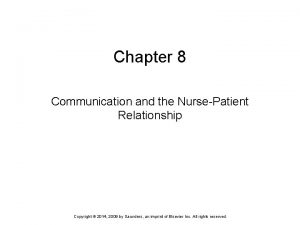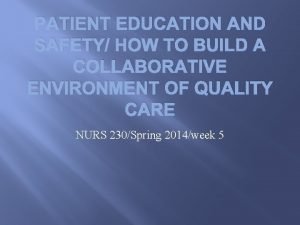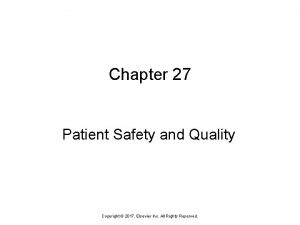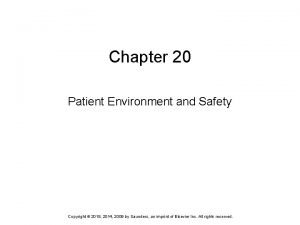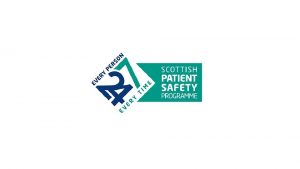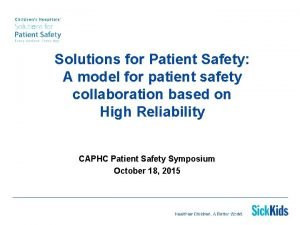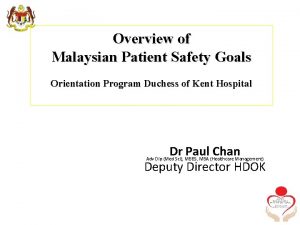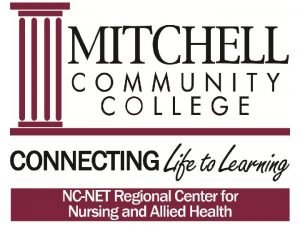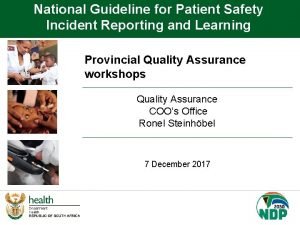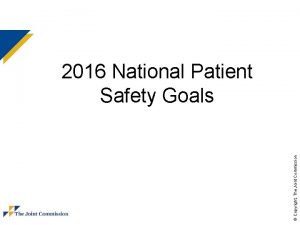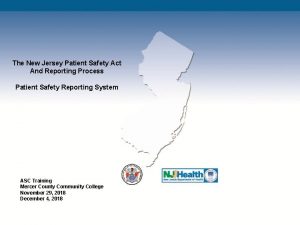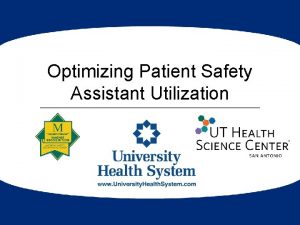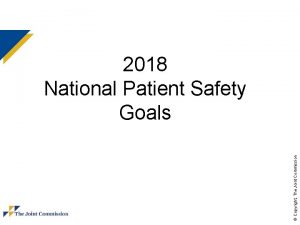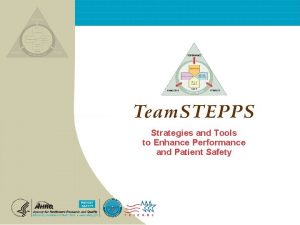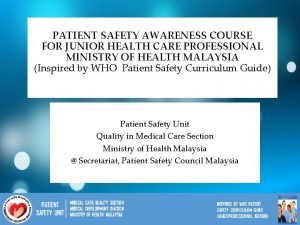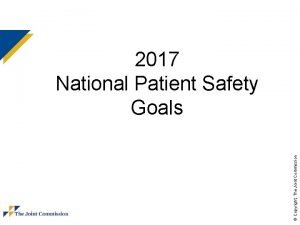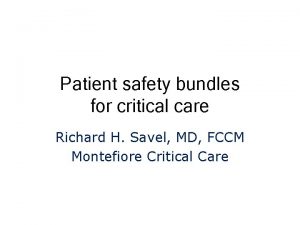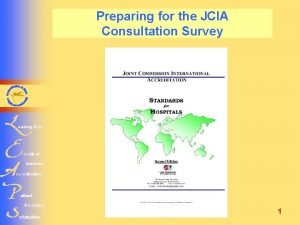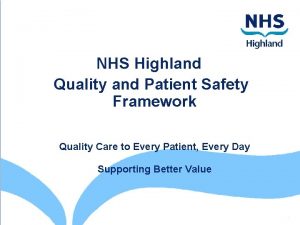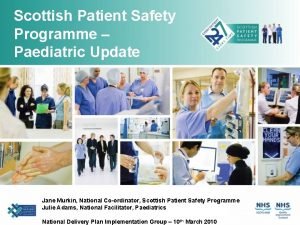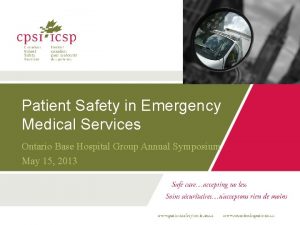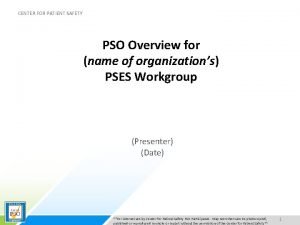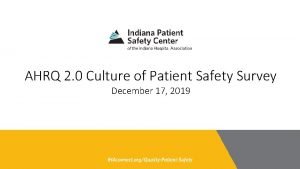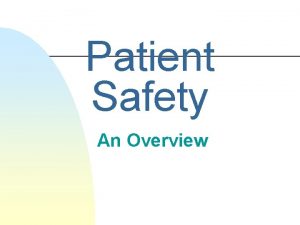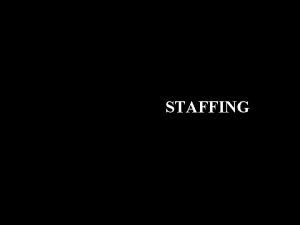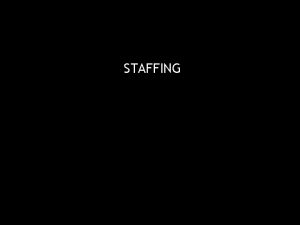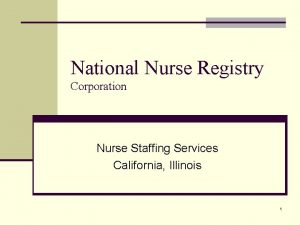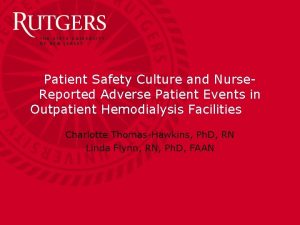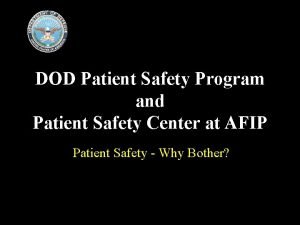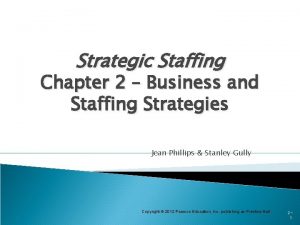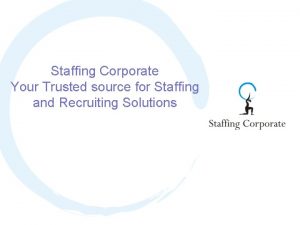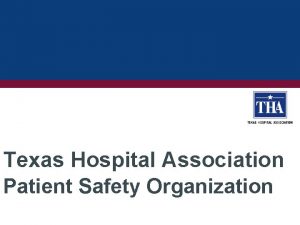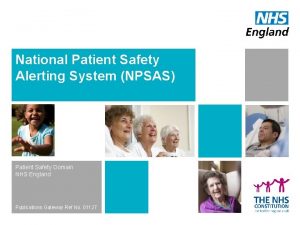Patient Safety and Nurse Staffing Does it really












































- Slides: 44

Patient Safety and Nurse Staffing Does it really make a difference?

Objectives • Discuss research on the relationship between staffing and quality of care • Analyze data on hospital staffing in the United States • Explore staffing-related policy options for ensuring quality of care

Objectives • Discuss research on the relationship between staffing and quality of care • Analyze data on hospital staffing in the United States • Explore staffing-related policy options for ensuring quality of care

What Do We Mean by Staffing? • • Staffing of licensed personnel Staffing of assistive and ancillary personnel Staffing in hospitals Staffing in long-term care facilities


Research on Nurse Staffing has Changed in Recent Years • In the 1990 s: – IOM said there was insufficient evidence to determine whether nurse staffing changes were detrimental (Crossing the Quality Chasm, 1996) – ANA said there was insufficient scientific evidence to establish ratios (1999)

The newest research shows that nurse staffing is important • Evidence suggests that an increase in nurse staffing is related to decreases in: – – – risk-adjusted mortality nosocomial infection rates thrombosis and pulmonary complications in surgical patients pressure ulcers readmission rates failure to rescue • Evidence that higher ratios of RNs to residents in longterm care has positive effects

The Most Influential Studies • Report for Health Resources and Services Administration – Use of administrative hospital data from states – Key outcomes associated with nurse staffing: • • • Urinary tract infections Pneumonia Length of stay Upper gastrointestinal bleeding Shock Failure to rescue Needleman, J. , Buerhaus, P. , Mattke, S. , Stewart, M. , & Zelevinsky, K. (2002). Nursestaffing levels and the quality of care in hospitals. New England Journal of Medicine, 346, 1715 -1722.

The Most Influential Studies • Survey of nurses about staffing and work environment in Pennsylvania, surveys linked to discharge data – For every patient added to the average hospital-wide nurse workload – 7% increase in mortality for every patient added to the – 7% increase in failure-to-rescue patients with complications • Patients in hospitals with 8: 1 patient to nurse ratios have more than a 30% greater risk of death following common surgical procedures than patients in hospitals with 4: 1 ratio • Some 4 million surgical procedures like the ones studied are performed annually in US hospitals. – If all patients were cared for in hospitals with 4 patients per nurse, up to 20, 000 fewer deaths might be expected. Aiken, L. H. , Clarke, S. P. , Sloane, D. M. , Sochalski, J. , & Silber J. H. (2002). Hospital nurse staffing and patient mortality, nurse burnout, and job dissatisfactions. Journal of the American Medical Association, 288, 1987 -1993.

The Most Influential Studies • Cross-sectional analyses of outcomes data for 232, 342 general, orthopedic, and vascular surgery patients discharged from 168 nonfederal adult general Pennsylvania hospitals – Hospitals with more baccalaureate-educated RNs had lower: – 30 -day mortality – Failure to rescue Aiken, L. H. , Clarke, S. P. , Cheung, R. B. , Sloan, D. M. , & Silber J. H. (2003). Educational levels of hospital nurses and surgical patient mortality. . Journal of the American Medical Association, 290, 1617 -1623.

The Most Influential Studies • Data for patients aged 18 years and older who were discharged between 1990 and 1996 were used to create hospital-level adverse event indicators. – Examined relationship between nurse staffing and four postsurgical adverse events: • • venous thrombosis/pulmonary embolism pulmonary compromise after surgery urinary tract infection pneumonia – Poor nurse staffing increased pneumonia rates Kovner, C. , Jones, C. , Zahn, C. , Gergen, P. J. , & Basu, J. (2002). Nurse staffing and postsurgical adverse events: An analysis of administrative data from a sample of U. S. hospitals, 1990 -1996. Health Serves Research, 37, 611 -629.


Nurse staffing also affects job satisfaction • High workload and poor staffing ratios are associated with: – Nurse burnout – Low job satisfaction – Increased nurse stress • Nurse stress is related to: – Adverse patient events – Nurse injuries – Quality of care – Patient satisfaction

Importance of Work Environment • Every blue ribbon commission report on solutions to cyclical nursing shortages since 1980 has recommended changes in nurses’ work environments – Recent reports: JCAHO, AHA, RWJF • However, on the whole nurses work environments have deteriorated over the past 2 decades

Nurses Highly Dissatisfied with Hospital Practice • • Job dissatisfaction High job burnout Intend to leave within year Under 30 leaving in year 41% 43% 23% 33%


Sources of Dissatisfaction • • • Too few RNs for quality care Increased patient assignment Inadequate support services Quality care deteriorating Not confident patients can manage at discharge 66% 83% 57% 45% 66%

Another Aiken Study Aiken, L. H. et al. (2001). Nurses' reports on hospital care in five countries. Health Affairs, 20(3), 43 -53. – Reports from 43, 000 nurses from more than 700 hospitals in the United States, Canada, England, Scotland, and Germany in 1998 -1999 – Core problems in work design and workforce management threaten the provision of care

Percent of Nurses Leaving Essential Nursing Care Undone Last Shift • • • U. S. Canada Germany Comforting patients 40 44 Skin care 31 35 31 Oral hygiene 20 22 10 Teaching patients/families 30 26 Discharge planning 13 14 Care planning 41 47 34 54 30 13

Percent of Nurses Performing Non. Nursing Tasks on Last Shift • • U. S. Canada Germany Food trays 43 40 72 Housekeeping 34 43 na Transport 46 33 54 Ancillary services 69 72 28

RNs Reporting Adverse Events as “Not Infrequent” • • • Wrong medication or dose • Nosocomial infection • Falls with injuries • Patient/Family Complaints • Verbal Abuse of Nurses 16% 35% 20% 49% 53%

Patient to Nurse Ratios Important in Nurse Retention • Higher burnout and greater job dissatisfaction are strongly related to patient-to-nurse ratios. – An increase of 1 patient per nurse increases the probability of • high levels of burnout by 23% • job dissatisfaction by 15% Aiken, L. H. , Clarke, S. P. , Sloane, D. M. , Sochalski, J. , & Silber J. H. (2002). Hospital nurse staffing and patient mortality, nurse burnout, and job dissatisfactions. Journal of the American Medical Association, 288, 1987 -1993.

The Research Has Limits • Data on hospitals do not recognize different staffing on different units • Studies at the nursing unit level involve primary data collection and are costly • Single-year studies cannot prove a causal relationships • No study identifies the “ideal” staffing ratio

Objectives • Review research on the relationship between staffing and quality of care • Present data on staffing in the United States • Explore staffing-related policy options for ensuring quality of care

There are many sources for nurse staffing data • American Hospital Association • State data • Original surveys

There are many ways to measure nurse staffing • Nurse-to-patient ratios – 1: 4, 1: 8, 1: 12 • Hours per patient day (HPPD) • Full-time equivalent employment (FTEE) – Someone who does 100% patient care = 1 FTEE – Someone who does 50% administration and 50% patient care = 0. 5 FTEE • Skill mix (how many RNs, LPNs, BSNs, PCTs? ? )

There is Wide Variation in HPPD Nationally 10 th 20 th Percentile Median 80 th 90 th Percentile RNs 4. 28 4. 66 5. 26 6. 05 6. 63 LPNs 0. 66 0. 74 1. 03 1. 49 2. 01 Source: AHA

What is Staffing in “Best Practices” Hospitals? • Best practices hospitals identified by: – American Nurses Association Magnet Hospitals – JCAHO Commendation of CA hospitals – US News rankings – national honor roll – USA Today Top 100

Average HPPD in Best Practices Hospitals # Hospitals RN HPPD LPN HPPD ANA Magnet 20 7. 35 0. 69 JCAHO 13 7. 22 0. 82 US News honor roll 20 7. 45 0. 45 USA Today 100 6. 13 0. 93 US average 5127 5. 75 1. 42 Source: AHA

Objectives • Review research on the relationship between staffing and quality of care • Present data on hospital staffing in the United States • Explore staffing-related policy options for ensuring quality of care

Rules and Regulations

Some States Have Adopted Some Rules • California – Hospitals must have a patient acuity system to determine staffing (1995) • Kentucky and Virginia (1998) – Hospitals must establish appropriate staffing methodology • Nevada (1999) – Hospitals must have a staffing methodology based on acuity

Some States Have Adopted Some Rules • Oregon (2001) – Hospitals must develop and implement staffing plans – Provisions for inspections and penalties established • Texas (2002) – Hospitals must adopt, implement, and enforce a written staffing plan • California – Hospitals must meet specific minimum nurse-to-patient ratios (1999, implemented 2004)

Florida 2005 • HB 1117 proposed the creation of the Safe Staffing for Quality Care Act, which would require ratio limits on nursing units • • • Critical care units Labor and delivery units Emergency departments Step-down units General medical/surgical 1: 2 nurse-to-patient ratio 1: 2 1: 3 1: 4 – Died in the Health Care Regulation Committee 05/06/05

Florida 2005 • Senate Bill 1176 also referred to the Safe Staffing for Quality Care Act and aimed to prescribe staffing standards for health care facilities. – Died in Committee on Health Care 05/06/05

Florida 2005 • Both Bills were – Supported by the Nurse Alliance of Florida, a labor union in south Florida • “Staffing ratios are crucial to patient safety, nurse satisfaction and hospital costs. ” – Maria Sanchez, member of the Alliance – Opposed by the Florida Nurses Association • “First of all, it is a nursing judgment to decide what care patients need. Second, ratios make all nurses the same. Every nurse, no matter how much experience or schooling she has, becomes a number. It’s demeaning to the profession, and when you put numbers on units, there’s no flexibility. It ties the hands of the nurses themselves. ” – Barbara Lumpkin, Associate Executive Director, FNA

Approaches to Staffing Standards • Patient acuity/patient classification systems • Fixed ratios • Formula-based ratios • Skill-mix requirements

Patient Acuity/Patient Classification Systems • Input: # of patients, acuity of illness • Output: appropriate staffing levels • Widely marketed systems and home-grown systems • Problems: – Systems best for long-term, not short-term, prediction – Difficulty of staffing up if necessary – Enforcement – hard to monitor

Fixed Ratios • Fixed, specific nurse-to-patient ratios are mandated • Problems: – Minimum staffing could become average staffing – Hospitals could eliminate ancillary and support staff – Enforcement – do you close hospitals? – Loss of flexibility and innovation

Formula-based Ratios • Nurse workload = function of: – RN staff expertise – Patient acuity, work intensity – Support staff, MD availability – Unit physical layout • Problems: – Defining the function – Establishing new staffing ratios every week/month/year – Enforcement

Skill-mix Requirements • Hospitals must have a minimum fixed ratio of licensed staff relative to all staff • Problems: – What is the appropriate ratio? – Minimum ratio could become average (like speed limit) – Total staffing may not be adequate – Loss of flexibility and innovation – Enforcement

An Overriding Question • How much are we willing to spend to increase quality of care? – Do we take money from schools? – Do we take money from salaries? – Do we increased the number of uninsured?

What Next? • More nurses lead to better patient outcomes • Legislative approaches have potential pitfalls • To improve nurse staffing: – Hospitals need money to pay more staff – More nurses are needed in the labor market

Responses to Hospital Nursing Shortages • Responding to a nursing shortage in the early 1980 s, the American Academy of Nursing embarked on the “magnet hospital” project – Identify hospitals that attract and retain nurses. – 1993 - the "magnet" concept by was formalized by the ANCC by establishing the Magnet Hospital Recognition Program for Excellence in Nursing Services Mc. Clure, M. L. , & Hinshaw, A. S. (Eds. ). (2002). Magnet hospitals revisited. Silver Spring, MD: American Nurses Association.
 Responsibilities of a scrub nurse
Responsibilities of a scrub nurse Therapeutic communication techniques
Therapeutic communication techniques Nurse logic ati
Nurse logic ati Does the cup and string work
Does the cup and string work Phases of nurse-patient relationship ppt
Phases of nurse-patient relationship ppt Nurse to patient ratio picot question
Nurse to patient ratio picot question Nurse-patient relationship phases
Nurse-patient relationship phases Phases of nurse patient relationship
Phases of nurse patient relationship Phases of nurse patient relationship
Phases of nurse patient relationship Mode of admission in hospital
Mode of admission in hospital The nurse has obtained the patient's oral medications
The nurse has obtained the patient's oral medications Role of nurse in patient teaching ppt
Role of nurse in patient teaching ppt Patient 2 patient
Patient 2 patient Chapter 27 patient safety and quality
Chapter 27 patient safety and quality Chapter 20 patient environment and safety
Chapter 20 patient environment and safety Patient safety and quality care movement
Patient safety and quality care movement Essentials of safe care
Essentials of safe care Solutions for patient safety
Solutions for patient safety Malaysian patient safety goals 2021
Malaysian patient safety goals 2021 National patient safety goals 2012
National patient safety goals 2012 Patient safety incident definition
Patient safety incident definition To err is human to cover up is unforgivable
To err is human to cover up is unforgivable 2016 national patient safety goals
2016 national patient safety goals History of patient safety
History of patient safety Nj patient safety act
Nj patient safety act Christine andre
Christine andre Dod patient safety program
Dod patient safety program Npsg 2018
Npsg 2018 Sue sheridan patient safety
Sue sheridan patient safety Patient safety council malaysia
Patient safety council malaysia National patient safety goals 2017
National patient safety goals 2017 Patient safety solutions
Patient safety solutions Ihi care bundles
Ihi care bundles Patient safety incident management system
Patient safety incident management system 2013 hospital national patient safety goals
2013 hospital national patient safety goals Patient safety goals
Patient safety goals National patient safety framework
National patient safety framework Npsg 8
Npsg 8 Jane murkin
Jane murkin Canadian patient safety officer course
Canadian patient safety officer course Patient safety evaluation system
Patient safety evaluation system Ahrq patient safety survey
Ahrq patient safety survey Basic aspirations of human being
Basic aspirations of human being And the tree was happy but not really
And the tree was happy but not really Examine mercutio grave man line
Examine mercutio grave man line

